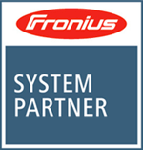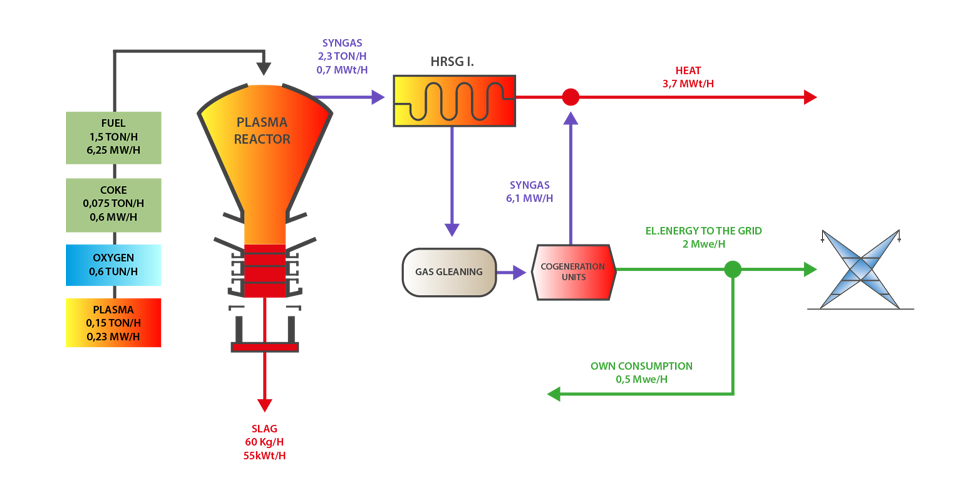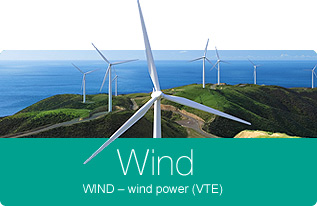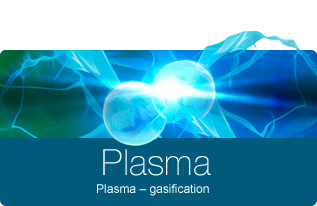Plasma gasification
We offer the following products and solutions:
photovoltaic power | wind power | small hydropower plants | plasma gasification
Plasma gasification is energy production of the 21 century
S.W.H. GROUP SE is your partner for realising projects involving the plasma gasification of organic matter to produce electricity and heat or the alternative production of liquid bio fuels. Thanks to the high temperatures achieved by the plasma torch technology, we can produce synthetic gas from organic matter in a clean manner. This is then processed as a raw material for producing energy or liquid fuels. The projects we have on offer process input fuel from various kinds of biomass, wastewater treatment sludge, municipal and industrial waste and even hazardous wastes.
WHAT IS GASIFICATION
Gasification is a pyrolysis process with partial oxidation in which organic matter in the solid state is transformed using high temperatures into the gaseous state. This gas is then used as a fuel as well as a raw material for making a whole range of substances. Gasification has been used in industry since the start of the 20th century. Our forebears gasified both wood, to drive cars on wood gas, and coal, to make coal-gas or Synthetic fuels using FT synthesis. The main difference compared to these older methods is in the source and manner of transmitting the energy in the input materials and in the more efficient control thanks to modern computer systems. Our facilities use thermal plasma
Thanks to the high temperatures and high energy density, the entire gasification process is more efficient and environmentally friendlier
WHAT IS A "PLASMA TORCH"
A plasma torch is a tool to make thermal plasma, which plasma gasification technology uses to provide the energy necessary to break down the input materials. Plasma is an ionised, conductive gas at a temperature of 4 – 5 000 °C, which arises when a stream of the carrier gas (air enriched with 93 % oxygen) is passed through an arc discharge. The extremely high temperature and energy density enable the rapid and comprehensive breakdown of all of the organic substances into their basic elements. The parallel process of partial oxidation provides the resulting gasification product – synthesis gas (CO + H2). Plasma torches were originally developed to test the resistance of the space shuttle's ceramic tiles, which encounter temperatures of over 2500 °C upon re-entry into the atmosphere.
WHAT CAN BE USED AS FUEL
In essence, any organic matter, i.e. matter containing carbon, can be a fuel for the plasma gasification process. Thanks to the high temperatures, the plasma gasification technology is also very robust and, depending on the technology installed, enables switching from various kinds of fuels. The common property is that the input fuel does not have a moisture content of over 20 %. If the biomass has more, it must be dried and if it is less, it is best to add water to the gasification process in the form of steam to optimise the formation and composition of the synthesis gas. In essence, the organic matter for the projects is differentiated on the basis of the categorisation of the products, those being:
1. renewable and
2. non-renewable matter.
FIVE TONNES – FUELS
The smallest system processes 1,5 tons of fuel per hour and supplies the grid (depending on the energy content of the fuel) with approximately 2 MW of electricity per hour.
Main technological components of the PGV process
1. Receiving, storage and transport of input materials to the reactor
2. Gasification reactor and accessories
3. Synthesis gas purification and treatment
4. Generation of heat and electricity
a) cogeneration units
b) steam turbine
5. Auxiliary operations
Process outputs
Electricity – Cogeneration units: 2,5 MWe/hr,
Internal consumption: 0,5 MWe/hr,
Total output to grid: 2 MWe/hr i.e. 16 GWe/year,
Total heat: 3,7 MWt/hod
Slag: 0.06 tons/hr
Our suppliers


We recommend our references
On the references you can find our most interesting projects that we have implemented in recent years.
Quick Contact
S.W.H. GROUP SE
Pobřežní number 620/3, 186 00 Prague 8 – Karlín
Czech Republic, Czech (+420) 728 327 766
Total operating time of 8,000 hours/year
Total input material 12,000 tons/year
Area of facility 150 x 120 m, max. height of 15m
Estimated investment costs 9 mil. EURO.









